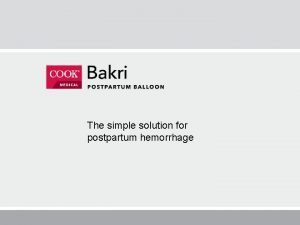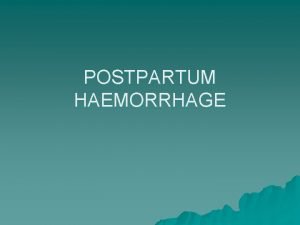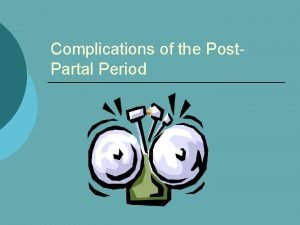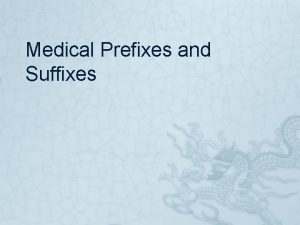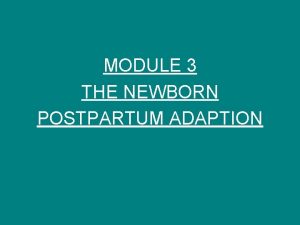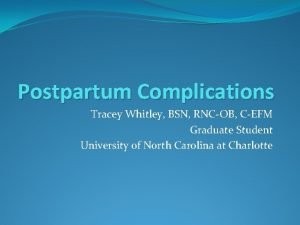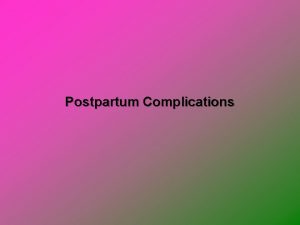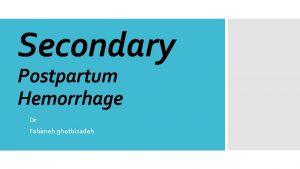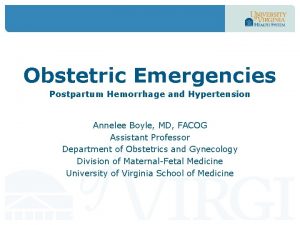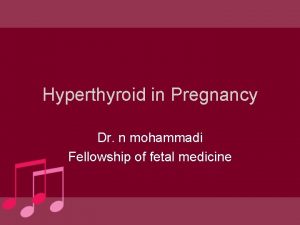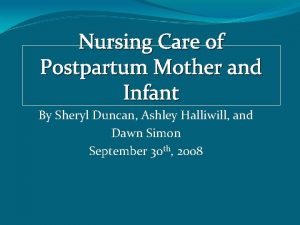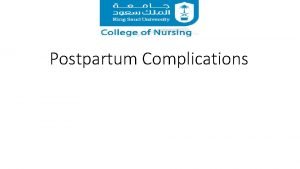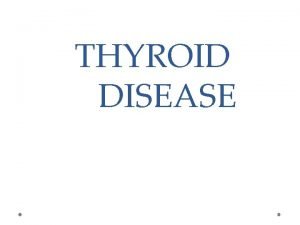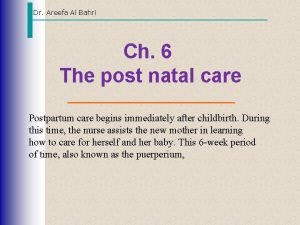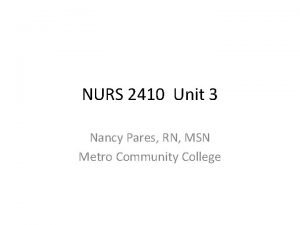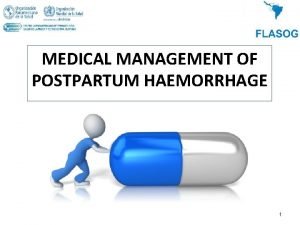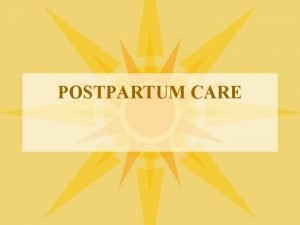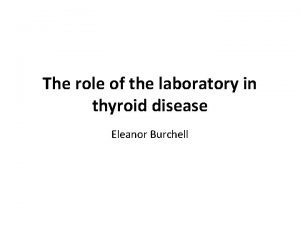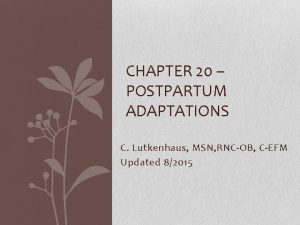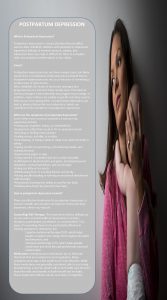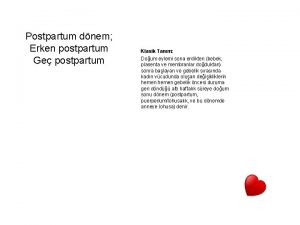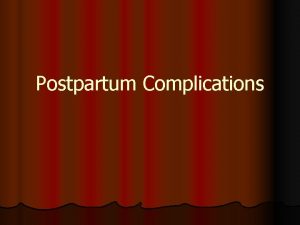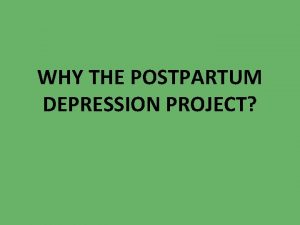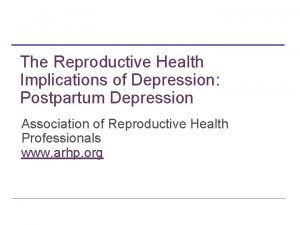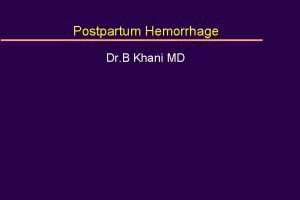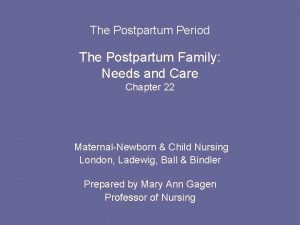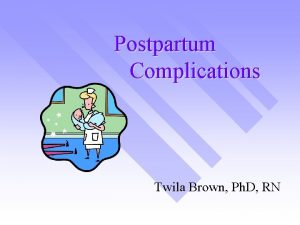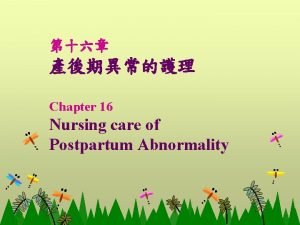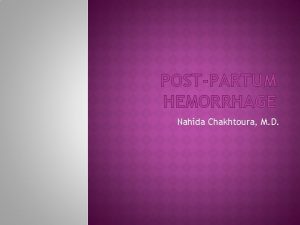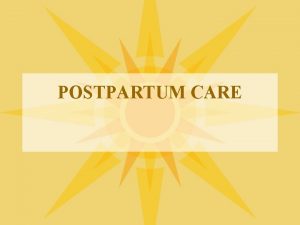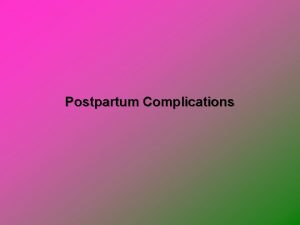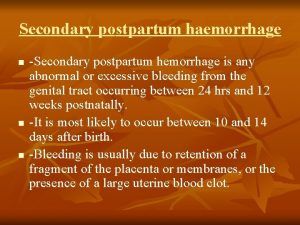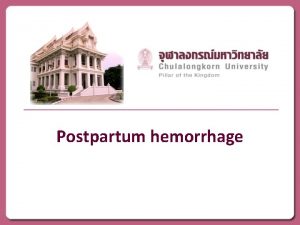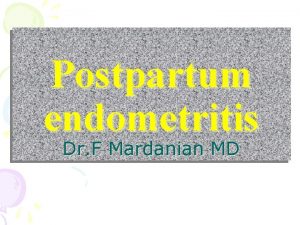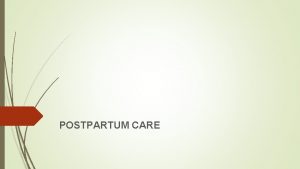The Recognition Treatment of Postpartum Depression Johna M






















- Slides: 22

The Recognition & Treatment of Postpartum Depression Johna M Bott Eileen Van Dyke 3/23/06

PPD n Characterized by despair, sadness, anxiety, fears, compulsive thoughts, feelings of inadequacy, loss of libido, fatigue, & dependency n Affects upwards of 20% of women after childbirth n Major health problem that threatens the family unit as a whole

Postpartum psychosis n Emergency that requires immediate hospitalization n Presents with mania, psychotic thoughts, severe depression n Rare occurring in 1 -2 deliveries out of a thousand

Why do we care? Affects entire family unit, not just the mother n One mother described PPD as being buried alive with no chance of clawing to the surface n While mom is debilitated, child’s cognitive and social development suffers then & potentially later on in life with the development of conduct & attention disorders n Fathers also affected by stress put on marriage n

PPD screening is not being done

Screening Approximately 50% of PPD cases go undiagnosed n Although family physicians believe PPD is serious, identifiable, and treatable, screening is still not standard clinical practice in the US n Clinical signs are often not apparent unless screened for n Screening tools are out there & some are even specific for PPD n

Excuses n OB screens for that n Pediatricians screen for that at well baby visits n There are too many tools out there, I don’t know which one to use n The tools are too complex n Is that my job?

Risk Factors n Prenatal depression n Totally independent of time n Any depression during pregnancy was discovered to be a significant predictor

Risk Factors n Child care stress n Childbirth itself is a traumatic stressful event that makes the mother more vulnerable to other stressors n Any stressful event involving the care of the newborn, including the temperament of the baby which may be fussy, irritable, and difficult to console n Unhealthy infants

Risk Factors n Support or lack there of n Social, emotional, and instrumental support is very important for new mothers and either perceiving a lack of it or actually having a lack of it can be very detrimental

Risk Factors n Life stress n The number of both positive and negative stressful life events that occur during pregnancy and the postpartum period

Risk Factors n Prenatal anxiety n Marital dissatisfaction n History of previous depression n Affective illness or previous PPD episode

Medical Problems with Related Sx n Transient hypothyroidism n Anemia n Diabetes n Other endocrine disorders n Abuse situations n Infection

Treatment Options n Individual psychotherapy n Personalized care n Scheduling flexibility n Group therapy n Not for everyone n Compliance issue with scheduling conflicts n Need adequate # to participate

Treatment Options n Pharmacologic treatment Selective serotonin reuptake inhibitors (SSRIs) n All antidepressants are secreted in breast milk n Continued at least six months to ensure complete remission n n Complementary or alternative treatments n Bright-light therapy, exercise, massage therapy, & chronobiological therapies, such as wake therapy

Treatment Options n Controversial therapies n Progesterone or estrogen injections n Hospitalization n Risk of suicide or infanticide n Antipsychotics n Electroconvulsive therapy

Available Screening Tools n n n n The Beck Depression Inventory The Bromley Postnatal Depression Scale The Center for Epidemiological Studies Depression Scale The General Health Questionnaire The Inventory of Depressive Symptomatology The Zung Self-Rating Depression Scale The Edinburgh Postnatal Depression Scale The Postpartum Depression Screening Scale

The Edinburgh Postnatal Depression Scale One of the best known screening scales for PPD n Measures emotional and cognitive symptoms of PPD n Ten items scored from 0 to 3 n Only somatic sx taken into account is sleeping difficulties n Available in multiple languages n

The Postpartum Depression Screening Scale Measures 7 dimensions of PPD including sleeping/eating disturbances, anxiety/insecurity, emotional liability, cognitive impairment, loss of self, guilt/shame, & contemplating harming oneself n 35 items n Excellent sensitivity & specificity n

Conclusion n The general consensus is that both the EPDS & the PDSS are good screening scales for PPD n Practitioners may form personal preferences due to length or detail of questions n Most important thing is that a screening method is used

Summary PPD is real & very serious n Talking about PPD openly might make it less scary, educate the patient & their family n Screening at every visit is the key to the difficult recognition that is due to drastic differences in symptoms from patient to patient n Prompt treatment with effective follow-up n

References n n n n Andrews-Fike C. A review of postpartum depression. Primary Care Companion Journal of Clinical Psychiatry. 1999; 1: 9 -14 Beck CT, Gable RK. Comparative analysis of the performance of the postpartum depression screening scale with two other depression instruments. Nursing Research. 2001 July/August; 50(4): 242 -250 Beck CT, Gable RK. Further validation of the postpartum depression screening scale. Nursing Research. 2001 May/June; 50(3): 155 -164 Beck CT, Indman P. The many faces of postpartum depression. JOGNN. 2005 September/October; 34(5): 569 -576 Benvenuti P, Ferrara M, Niccolai C, Valoriani V, Cox J. The Edinburgh postnatal depression scale: validation for and Italian sample. Journal of Affective Disorders. 1999; 53: 137 -141 Boyd RC, Le HN, Somberg R. Review of screening instruments for postpartum depression. Archives of Women’s Mental Health. 2005; 8: 141 -153 Dalton K, Holton WM. Depression after childbirth: how to recognize, treat, and prevent postnatal depression. 3 rd ed. Oxford: Oxford University Press; 1996 Dennis C-L, Creedy D. Psychosocial and psychological interventions for preventing postpartum depression. The Cochrane Database of Systematic Reviews. 2004, Issue 4. Art. No. : CD 001134. pub 2. DOI: 10. 1002/14651858. CD 001134. pub 2 Edhborg M, Friberg M, Lundh W, Widstrom AM. “Struggling with life”. Narratives from women with signs of postpartum depression. Scandinavian Journal of Public Health. 2005 Aug; 33(4): 261 -267 Hanna B, Jarman H, Savage S. The clinical application of three screening tools for recognizing post-partum depression. International Journal of Nursing Practice. 2004; 10: 72 -9 Horowitz JA, Goodman JH. Identifying and treating postpartum depression. JOGNN. 2005 March/April; 34(2): 264 -273 Lee DTS, Yip ASK, Chan SSM, Tsiu MHY, Wong WS, Chung TKH. Postdelivery screening for postpartum depression. Psychosomatic Medicine. 2003; 65: 357 -361 O’Hara MW, Cohen LS. Postpartum depression: causes and consequences. New York: Springer-Verlag; 1995 Seehusen DA, Baldwin LM, Runkle GP, Clark G. Are family physicians appropriately screening for postpartum depression? JABFP. 2005 March/April; 18(2): 104 -112 Stowe ZN, Hostetter AL, Newport J. The onset of postpartum depression: implications for clinical screening in obstetrical and primary care. American Journal of Obstetrics and Gynecology. 2005 Feb; 192(2): 522 -6 Whiffen VE. Screening for postpartum depression: a methodological note. Journal of Clinical Psychology. 1988 May; 44(3): 367 -371
 Pph management
Pph management Defination of pph
Defination of pph Postpartum hemorrhage treatment drugs
Postpartum hemorrhage treatment drugs Root word medical terminology examples
Root word medical terminology examples Bubble postpartum
Bubble postpartum Nursing management of pph
Nursing management of pph Postpartum infection
Postpartum infection Haemabate
Haemabate Postpartum hemorrhage
Postpartum hemorrhage Postpartum thyroiditis
Postpartum thyroiditis Postpartum infections
Postpartum infections Quad screen results chart
Quad screen results chart Secondary postpartum haemorrhage
Secondary postpartum haemorrhage Postpartum thyroiditis
Postpartum thyroiditis Bubble-he assessment
Bubble-he assessment Homan signs
Homan signs Mk clinical management ug
Mk clinical management ug Psychological adaptation in postpartum
Psychological adaptation in postpartum Carbimazole dose
Carbimazole dose Fundus fiddling
Fundus fiddling Bubble he
Bubble he Chapter 20 postpartum adaptations
Chapter 20 postpartum adaptations độ dài liên kết
độ dài liên kết
